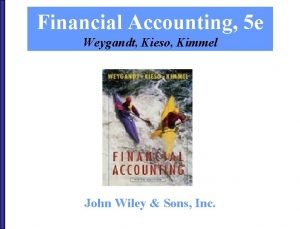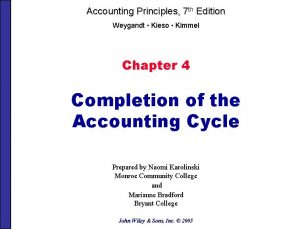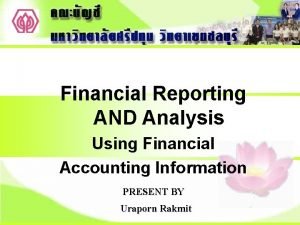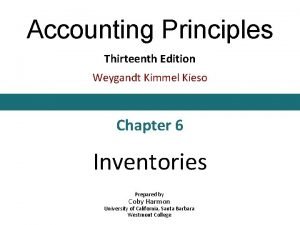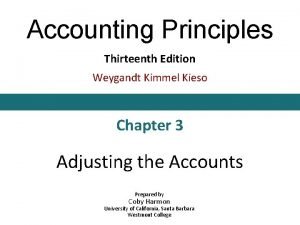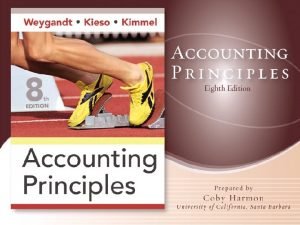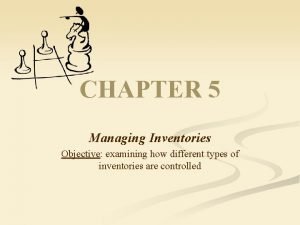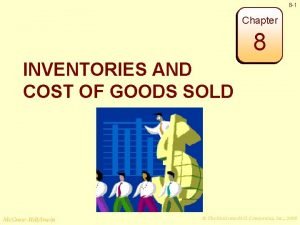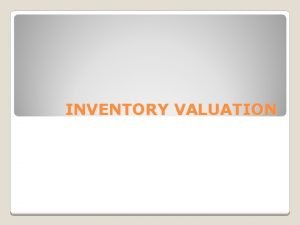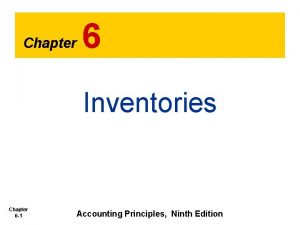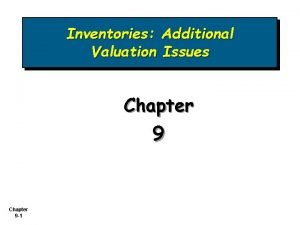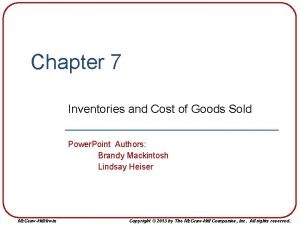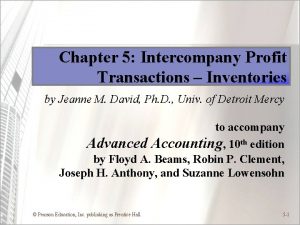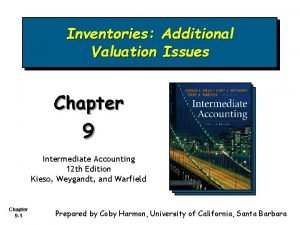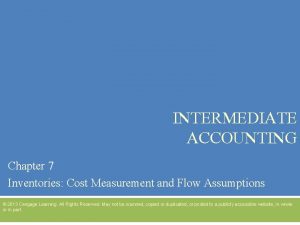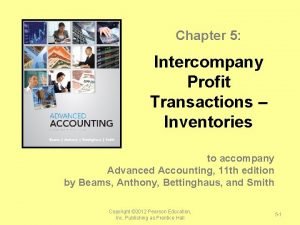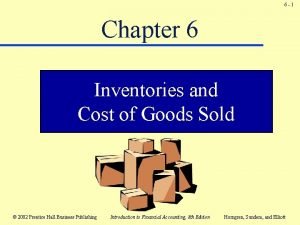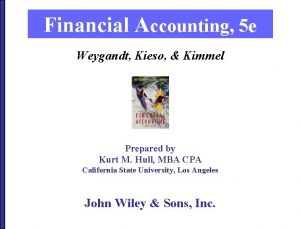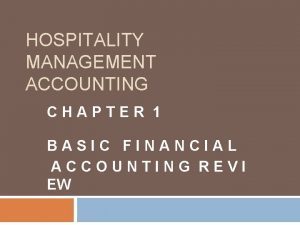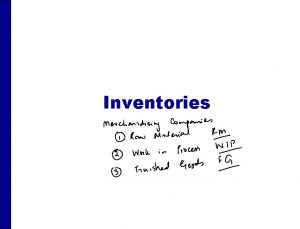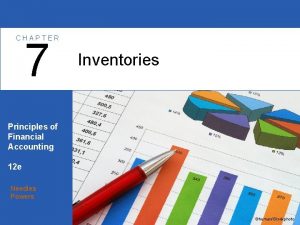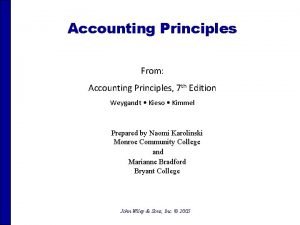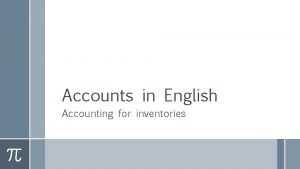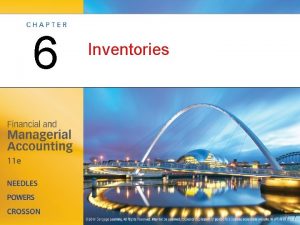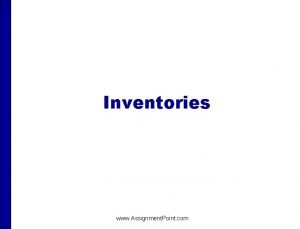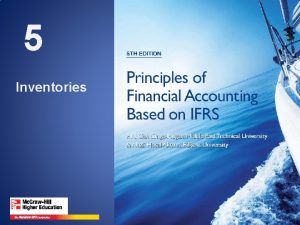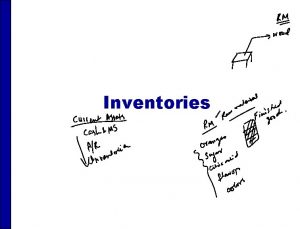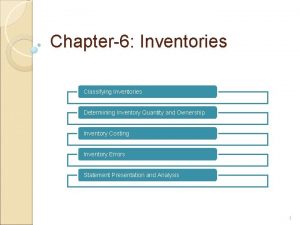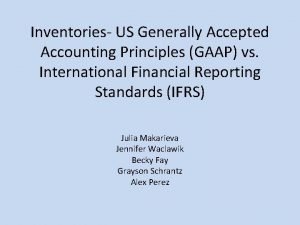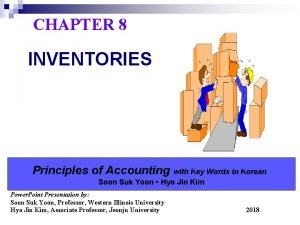Inventories Principles of Financial Accounting 10 th Edition




































- Slides: 36

Inventories Principles of Financial Accounting, 10 th Edition Slides 71

Classifying Inventory Merchandising Company One Classification: Merchandise Inventory Manufacturing Company Three Classifications: Raw Materials Work in Process Finished Goods Regardless of the classification, companies report all inventories under Current Assets on the balance sheet. Slides 72

Determining Inventory Quantities Physical Inventory taken for two reasons: Perpetual System 1. Check accuracy of inventory records. 2. Determine amount of inventory lost (wasted raw materials, shoplifting, or employee theft). Periodic System 1. Determine the inventory on hand 2. Determine the cost of goods sold for the period. Slides 73 SO 1 Describe the steps in determining inventory quantities.

Determining Inventory Quantities Determining Ownership of Goods in Transit Purchased goods not yet received. Sold goods not yet delivered. Goods in transit should be included in the inventory of the company that has legal title to the goods. Legal title is determined by the terms of sale. Slides 74 SO 1 Describe the steps in determining inventory quantities.

Determining Inventory Quantities Terms of Sale Illustration 6 -1 Ownership of the goods passes to the buyer when the public carrier accepts the goods from the seller. Ownership of the goods remains with the seller until the goods reach the buyer. Slides 75 SO 1 Describe the steps in determining inventory quantities.

Determining Inventory Quantities Review Question Goods in transit should be included in the inventory of the buyer when the: a. public carrier accepts the goods from the seller. b. goods reach the buyer. c. terms of sale are FOB destination. d. terms of sale are FOB shipping point. Slides 76 SO 1 Describe the steps in determining inventory quantities.

Determining Inventory Quantities Determining Ownership of Goods Consigned Goods held for sale by one party although ownership of the goods is retained by another party. Slides 77 SO 1 Describe the steps in determining inventory quantities.

Inventory Costing Unit costs can be applied to quantities on hand using the following costing methods: Specific Identification First-in, first-out (FIFO) Last-in, first-out (LIFO) Cost Flow Assumptions Average-cost Slides 78 SO 2 Explain the basis of accounting for inventories and apply the inventory cost flow methods under a periodic inventory system.

Inventory Costing Illustration: Assume that Crivitz TV Company purchases three identical 46 -inch TVs on different dates at costs of $700, $750, and $800. During the year Crivitz sold two sets at $1, 200 each. These facts are summarized below. Illustration 6 -2 Slides 79 SO 2 Explain the basis of accounting for inventories and apply the inventory cost flow methods under a periodic inventory system.

Inventory Costing “Specific Identification” If Crivitz sold the TVs it purchased on February 3 and May 22, then its cost of goods sold is $1, 500 ($700 + $800), and its ending inventory is $750. Illustration 6 -3 Slides 710 SO 2 Explain the basis of accounting for inventories and apply the inventory cost flow methods under a periodic inventory system.

Inventory Costing Specific Identification Method An actual physical flow costing method in which items still in inventory are specifically costed to arrive at the total cost of the ending inventory. Practice is relatively rare. Most companies make assumptions (Cost Flow Assumptions) about which units were sold. Slides 711 SO 2 Explain the basis of accounting for inventories and apply the inventory cost flow methods under a periodic inventory system.

Inventory Costing – Cost Flow Assumptions Cost Flow Assumption does not need to equal Physical Movement of Goods Illustration 6 -11 Use of cost flow methods in major U. S. companies Slides 712 SO 2 Explain the basis of accounting for inventories and apply the inventory cost flow methods under a periodic inventory system.

Inventory Costing – Cost Flow Assumptions Illustration: Data for Houston Electronics’ Astro condensers. Illustration 6 -4 (Beginning Inventory + Purchases) - Ending Inventory = Cost of Goods Sold Slides 713 SO 2 Explain the basis of accounting for inventories and apply the inventory cost flow methods under a periodic inventory system.

Inventory Costing – Cost Flow Assumptions “First-In-First-Out (FIFO)” Earliest goods purchased are first to be sold. Often parallels actual physical flow of merchandise. Generally good business practice to sell oldest units first. Slides 714 SO 2 Explain the basis of accounting for inventories and apply the inventory cost flow methods under a periodic inventory system.

Inventory Costing – Cost Flow Assumptions “First-In-First-Out (FIFO)” Illustration 6 -5 Solution on notes page Slides 715 SO 2 Explain the basis of accounting for inventories and apply the inventory cost flow methods under a periodic inventory system.

Inventory Costing – Cost Flow Assumptions “Last-In-First-Out (LIFO)” Latest goods purchased are first to be sold. Seldom coincides with actual physical flow of merchandise. Exceptions include goods stored in piles, such as coal or hay. Slides 716 SO 2 Explain the basis of accounting for inventories and apply the inventory cost flow methods under a periodic inventory system.

Inventory Costing – Cost Flow Assumptions “Last-In-First-Out (LIFO)” Illustration 6 -7 Solution on notes page Slides 717 SO 2 Explain the basis of accounting for inventories and apply the cost flow methods under a periodic inventory system. inventory

Inventory Costing – Cost Flow Assumptions “Average Cost” Allocates cost of goods available for sale on the basis of weighted average unit cost incurred. Assumes goods are similar in nature. Applies weighted average unit cost to the units on hand to determine cost of the ending inventory. Slides 718 SO 2 Explain the basis of accounting for inventories and apply the inventory cost flow methods under a periodic inventory system.

Inventory Costing – Cost Flow Assumptions “Average Cost” Illustration 6 -10 Solution on notes page Slides 719 SO 2 Explain the basis of accounting for inventories and apply the inventory cost flow methods under a periodic inventory system.

Inventory Costing – Cost Flow Assumptions Comparative Financial Statement Summary FIFO Slides 720 Average LIFO Sales Cost of goods sold Gross profit Admin. & selling expense Income before taxes Income tax expense Net income $9, 000 6, 200 6, 600 2, 800 2, 400 330 2, 470 2, 070 140 120 $2, 330 $1, 950 $9, 000 7, 000 2, 000 330 1, 670 110 $1, 560 Inventory balance $5, 800 $5, 400 $5, 000 LO 3 Explain the financial statement and tax effects of each of the inventory cost flow assumptions.

Inventory Costing – Cost Flow Assumptions In Period of Rising Prices, FIFO Reports: FIFO Lowest Highest Slides 721 Average LIFO Sales $9, 000 Cost of goods sold 6, 200 6, 600 Gross profit 2, 800 2, 400 Admin. & selling expense 330 Income before taxes 2, 470 2, 070 Income tax expense 140 120 Net income $2, 330 $1, 950 $9, 000 7, 000 2, 000 330 1, 670 110 $1, 560 Inventory balance $5, 000 $5, 800 $5, 400 LO 3 Explain the financial statement and tax effects of each of the inventory cost flow assumptions.

Inventory Costing – Cost Flow Assumptions In Period of Rising Prices, LIFO Reports: FIFO Highest Lowest Slides 722 Average LIFO Sales $9, 000 Cost of goods sold 6, 200 6, 600 Gross profit 2, 800 2, 400 Admin. & selling expense 330 Income before taxes 2, 470 2, 070 Income tax expense 140 120 Net income $2, 330 $1, 950 $9, 000 7, 000 2, 000 330 1, 670 110 $1, 560 Inventory balance $5, 000 $5, 800 $5, 400 LO 3 Explain the financial statement and tax effects of each of the inventory cost flow assumptions.

Inventory Costing – Cost Flow Assumptions Review Question The cost flow method that often parallels the actual physical flow of merchandise is the: a. FIFO method. b. LIFO method. c. average cost method. d. gross profit method. Slides 723 LO 3 Explain the financial statement and tax effects of each of the inventory cost flow assumptions.

Inventory Costing – Cost Flow Assumptions Review Question In a period of inflation, the cost flow method that results in the lowest income taxes is the: a. FIFO method. b. LIFO method. c. average cost method. d. gross profit method. Slides 724 LO 3 Explain the financial statement and tax effects of each of the inventory cost flow assumptions.

Inventory Costing Using Cost Flow Methods Consistently Method should be used consistently, enhances comparability. Although consistency is preferred, a company may change its inventory costing method. Illustration 6 -14 Disclosure of change in cost flow method Slides 725 LO 3 Explain the financial statement and tax effects of each of the inventory cost flow assumptions.

Inventory Costing Lower-of-Cost-or-Market When the value of inventory is lower than its cost Companies can “write down” the inventory to its market value in the period in which the price decline occurs. Market value = Replacement Cost Example of conservatism. Slides 726 SO 4 Explain the lower-of-cost-or-market basis of accounting for inventories.

Inventory Costing Lower-of-Cost-or-Market Illustration: Assume that Ken Tuckie TV has the following lines of merchandise with costs and market values as indicated. $ 55, 000 45, 000 12, 800 $157, 800 Slides 727 SO 4 Explain the lower-of-cost-or-market basis of accounting for inventories.

Analysis of Inventory management is a double-edged sword 1. High Inventory Levels - may incur high carrying costs (e. g. , investment, storage, insurance, obsolescence, and damage). 2. Low Inventory Levels – may lead to stockouts and lost sales. Slides 728 SO 5 Compute and interpret the inventory turnover ratio.

Analysis of Inventory turnover measures the number of times on average the inventory is sold during the period. Inventory Turnover = Cost of Goods Sold Average Inventory Days in inventory measures the average number of days inventory is held. Days in Year (365) Days in = Inventory Turnover Slides 729 SO 5 Compute and interpret the inventory turnover ratio.

Analysis of Inventory Illustration: The following data are available for Wal-Mart. Inventory Turnover 2007 Days in inventory 2007 Slides 730 = = $264, 152 (33, 685 + 31, 910) / 2 365 Days 8. 1 = 8. 1 times = 45. 1 Days SO 5 Compute and interpret the inventory turnover ratio.

Analysis of Inventory Illustration: The following data are available for Wal-Mart. Inventory Turnover 2006 Days in inventory 2006 Slides 731 = = $237, 649 (31, 910 + 29, 419) / 2 365 Days 7. 7 = 7. 7 times = 47. 4 Days SO 5 Compute and interpret the inventory turnover ratio.

Cost Flow Methods in Perpetual Systems Illustration: Appendix 6 A Illustration 6 A-1 Assuming the Perpetual Inventory System, compute Cost of Goods Sold and Ending Inventory under FIFO, LIFO, and Average cost. Slides 732 SO 7 Apply the inventory cost flow methods to perpetual inventory records.

Cost Flow Methods in Perpetual Systems “First-In-First-Out (FIFO)” Cost of Goods Sold Slides 733 Illustration 6 A-2 Ending Inventory SO 7 Apply the inventory cost flow methods to perpetual inventory records.

Cost Flow Methods in Perpetual Systems “Last-In-First-Out (LIFO)” Cost of Goods Sold Slides 734 Illustration 6 A-3 Ending Inventory SO 7 Apply the inventory cost flow methods to perpetual inventory records.

Cost Flow Methods in Perpetual Systems “Average Cost” (Moving-Average System) Cost of Goods Sold Slides 735 Illustration 6 A-4 Ending Inventory SO 7 Apply the inventory cost flow methods to perpetual inventory records.

Copyright “Copyright © 2009 John Wiley & Sons, Inc. All rights reserved. Reproduction or translation of this work beyond that permitted in Section 117 of the 1976 United States Copyright Act without the express written permission of the copyright owner is unlawful. Request for further information should be addressed to the Permissions Department, John Wiley & Sons, Inc. The purchaser may make back-up copies for his/her own use only and not for distribution or resale. The Publisher assumes no responsibility for errors, omissions, or damages, caused by the use of these programs or from the use of the information contained herein. ” Slides 736
 Kimmel accounting 5e
Kimmel accounting 5e Kimmel financial accounting 7the edition
Kimmel financial accounting 7the edition Financial accounting ifrs 4th edition chapter 12
Financial accounting ifrs 4th edition chapter 12 Using financial accounting information 10th edition
Using financial accounting information 10th edition Accounting principles second canadian edition
Accounting principles second canadian edition Accounting principles second canadian edition
Accounting principles second canadian edition Accounting principles second canadian edition
Accounting principles second canadian edition Beginning inventory formula
Beginning inventory formula Accounting principles second canadian edition
Accounting principles second canadian edition Accounting principles 13th edition
Accounting principles 13th edition Intermediate accounting chapter 1
Intermediate accounting chapter 1 Responsibility centers in management accounting
Responsibility centers in management accounting Formal reading assessment
Formal reading assessment What are inventories on a balance sheet
What are inventories on a balance sheet Non recycled inventory examples
Non recycled inventory examples Chapter 8 inventories and the cost of goods sold
Chapter 8 inventories and the cost of goods sold Mnemjian inventories
Mnemjian inventories Juloidian inventories
Juloidian inventories Selective inventory management
Selective inventory management Principles of accounting chapter 6 answers
Principles of accounting chapter 6 answers Chapter 9 inventories additional valuation issues
Chapter 9 inventories additional valuation issues Chapter 7 inventories
Chapter 7 inventories Intercompany inventory transactions
Intercompany inventory transactions Lower-of-cost-or-market
Lower-of-cost-or-market Dollar value lifo
Dollar value lifo Intercompany journal entries
Intercompany journal entries Smarter inventories
Smarter inventories Chapter 6 inventories
Chapter 6 inventories Mis chapter 6
Mis chapter 6 Using mis 10th edition
Using mis 10th edition International financial management jeff madura 13th edition
International financial management jeff madura 13th edition Expanded opportunity set international finance
Expanded opportunity set international finance International financial management definition
International financial management definition International financial management 13th edition
International financial management 13th edition International financial management 5th edition
International financial management 5th edition Kimmel weygandt kieso accounting 5th edition
Kimmel weygandt kieso accounting 5th edition Accounting for hospitality managers
Accounting for hospitality managers
